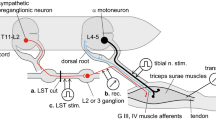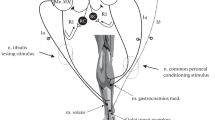Summary
1. The muscle tremor induced in cats by cerebral intraventricular curarine perfusion (“curarine tremor”, CT) is shown to be dependent upon intact proprioceptive afferent inflow to the spinal cord and some particular change of fusimotor drive to the muscle spindles:
2. Surgical deafferentation of a leg (section of lumbar dorsal roots) or generalized pharmacological deafferentation by endoanesthesia (benzononatine, 2–5 mg/kg i.v.) removed or at least greatly diminished all signs of CT in the leg or in the whole body.
3. Muscle tendon taps or contraction jerks interfering with a CT caused a variety of transient disorders of its rhythms in synergistic and antagonistic muscles, being probably due to muscle spindle rather than tendon organ disturbances.
4. Moderate increases of fusimotor output to the spindles, either occurring spontaneously or induced by pinna twist, enhanced the CT; strong or excessive fusimotor activation, however, revealing a qualitative shift of γ-impulse patterns, rather depressed the CT. A similar dose-dependent reversal of effects upon the CT was observed during chemical excitation of muscle spindles by means of succinylcholine.
5. Pharmacological blockage of supraspinal fusimotor drive by central relaxants (chlorpromazine, meprobamate) abolished or reduced an existing CT.
Zusammenfassung
1. Es wird gezeigt, daß das Muskelzittern der Katze bei Curareperfusion der Hirnventrikel („Curarezittern“, CZ) abhängig ist vom Einstrom proprioceptiver Afferenzen in das Rückenmark und von einer besonderen Änderung der fusimotorischen Antriebe zu den Muskelspindeln:
2. Operative Deafferentierung eines Beines oder allgemeine pharmakologische Deafferentierung durch Endoanaesthesie (Tessalon = Benzononatin, 2–5 mg/kg i.v.) beseitigte oder reduzierte bis auf Restspuren alle Zeichen eines CZ in dem Bein oder im ganzen Körper.
3. In ein CZ eingeblendete Sehnenschläge oder Zuckungskontraktionen bewirkten an synergistischen und antagonistischen Muskeln verschiedenste flüchtige Rhythmusstörungen, die eher auf die Muskelspindeln als auf die Sehnenorgane zurückführbar erschienen.
4. Mäßige Steigerungen der die Spindeln erreichenden fusimotorischen Aktivitäten — entweder spontan auftretend oder durch Pinna-Zwirbelung ausgelöst — verstärkten das CZ; bei zu starker oder exzessiver fusimotorischer Aktivierung, die mit qualitativer Änderung der γ-Impulsmuster einherging, wurde dagegen das CZ unterdrückt. Ähnliche dosisabhängige Umkehreffekte auf das CZ wurden bei chemischer Erregung der Muskelspindeln mittels Succinylcholin beobachtet.
5. Durch pharmakologische Blockierung der supraspinalen fusimotorischen Antriebe mittels zentraler Relaxantien (Chlorpromazin, Meprobamat) wurde ein bestehendes CZ aufgehoben oder reduziert.
Similar content being viewed by others
Literatur
Boyd, I. A.: The structure and innervation of the nuclear bag muscle fibre system and nuclear chain muscle fibre system in mammalian muscle spindles. Phil. Trans. B 245, 81–136 (1962).
Brinling, I. C., and C. M. Smith: A characterization of the stimulation of mammalian muscle spindles by succinylcholine. J. Pharmacol. exp. Ther. 129, 56–60 (1960).
Bruggencate, H. G. ten, H.-D. Henatsch u. H. Bossmann: Tremor und spinalmotorische α- und γ-Systeme der Katze bei Curareperfusion der Hirnventrikel. Pflügers Arch. ges. Physiol. 282, 102–118 (1965).
Busch, G., H.-D. Henatsch u. F. J. Schulte: Elektrophysiologische Analyse der Wirkungen neuroleptischer und tranquilisierender Substanzen (Phenothiazine, Meprobamat) auf die spinalmotorischen Systeme. Arzneimittel-Forsch. 11, 217–223 (1960).
Carmichael, E. A., W. Feldberg, and K. Fleischhauer: The site of origin of the tremor produced by tubocurarine acting from the cerebral ventricles. J. Physiol. (Lond.) 162, 539–554 (1962).
Eldred, E., K. Ott, K. Ishikawa, and D. Stuart: Proprioceptive contributions to the shivering tremor. In: Nobel Symposium I (Stockholm, June 1965), p. 151–163. Stockholm: Almquist u. Wiksell 1966.
Feldberg, W.: A pharmacological approach to the brain from its inner and outer surface. Evarts Graham Memorial Lectures, 1961. London: E. Arnold Publ. 1963.
W. Feldberg, and K. Fleischhauer: The site of origin of the seizure discharge produced by tubocurarine acting from the cerebral ventricles. J. Physiol. (Lond.) 160, 258–283 (1962).
Granit, R., C. Job, and B. R. Kaada: Activation of muscle spindles in pinna reflex. Acta physiol. scand. 27, 161–168 (1953a).
—, and S. Thesleff: Activation of muscle spindles by succinylcholine and decamethonium. The effects of curare. Acta physiol. scand. 28, 134–151 (1953b).
Gybels, I. M.: The neural mechanism of parkinsonian tremor. Bruxelles: Editions Arscia 1963.
Henatsch, H.-D.: Effects of chemically excited muscle spindles on spinal motoneurones in cats. In: Symposium on Muscle Receptors (Hong Kong), pp. 67–80. Hong Kong: University Press 1962.
H.-D., Henatsch Spinal motor systems and dynamic/static properties of muscle spindles in experimental tremor states of the cat. In: Nobel Symposium I (Stockholm, June 1965), pp. 165–176. Stockholm: Almquist u. Wiksell 1966.
H.-D. Henatsch D. H. Ingvar: Chlorpromazin und Spastizität. Eine experimentelle elektrophysiologische Untersuchung. Arch. Psychiat. Nervenkr. 195, 77–93 (1956).
H. -D. Henatsch E. D. Schomburg: Fusimotorische Effekte bei mechanischer und elektrischer Pinna-Reizung an decerebrierten und narkotisierten Katzen. Pflügers Arch. ges. Physiol. 281, 43 (1964).
--, u. F. J. Schulte: Unveröffentl. Beobachtungen (1958).
Hufschmidt, H. J.: Proprioceptive origin of parkinsonian tremor. Nature (Lond.) 200, 367–368 (1963).
Langrehr, D.: Zur Frage der Receptorspezifität endoanaesthetischer Wirkungen am Beispiel des Benzononatin (Tessalon). Naunyn-Schmiedebergs Arch. exp. Path. Pharmak. 245, 427–439 (1963).
Lippold, O. C. J., J. W. T. Redfearn, and J. Vuco: The influence of afferent and descending pathways on the rhythmical and arrhythmical components of muscular activity in man and the anaesthetized cat. J. Physiol. (Lond.) 146, 1–9 (1959).
Matthews, P. B. C.: Muscle spindles and their motor control. Physiol. Rev. 44, 219–289 (1964).
Pascoe, J. E.: Fusimotor neurones of the semitendinosus muscle of the rabbit. J. Physiol. (Lond.) 167, 34–35 P (1963).
Perkins, J. F., jr.: The role of proprioceptors in shivering. Amer. J. Physiol. 145, 264–271 (1945).
Pierau, F.-K.: Die Wirkung von Endoanaesthetica auf Kaltreceptoren. Pflügers Arch. ges. Physiol. 281, 69 (1964).
— K. Olesch u. F. W. Klussmann: Hemmung des Kältezitterns durch Endoanaesthesie. Pflügers Arch. ges. Physiol. 284, 301–315 (1965).
Schomburg, E. D.: Fusimotorische Effekte bei mechanischer und elektrischer Pinna-Reizung an decerebrierten und narkotisierten Katzen. Dissertation, Göttingen 1965.
Smith, C. M.: Neuromuscular pharmacology: drugs and muscle spindles. Ann. Rev. Pharmacol. 3, 223–242 (1963).
Stuart, D. G., and R. W. Porter: Proprioceptive contribution to shivering. Fed. Proc. 23, 567 (1964).
Zipf, H. F.: In H. Killian: Lokalanaesthesie und Lokalanaesthetika, p. 138ff. Stuttgart: G. Thieme 1959.
Author information
Authors and Affiliations
Rights and permissions
About this article
Cite this article
Henatsch, HD., ten Bruggencate, H.G. & Bossmann, H. Bedeutung der Proprioceptoren und der γ-Muskelspindel-Schleife für das „Curarezittern“ der Katze. Pflügers Archiv 292, 356–373 (1966). https://doi.org/10.1007/BF00363203
Received:
Issue Date:
DOI: https://doi.org/10.1007/BF00363203




